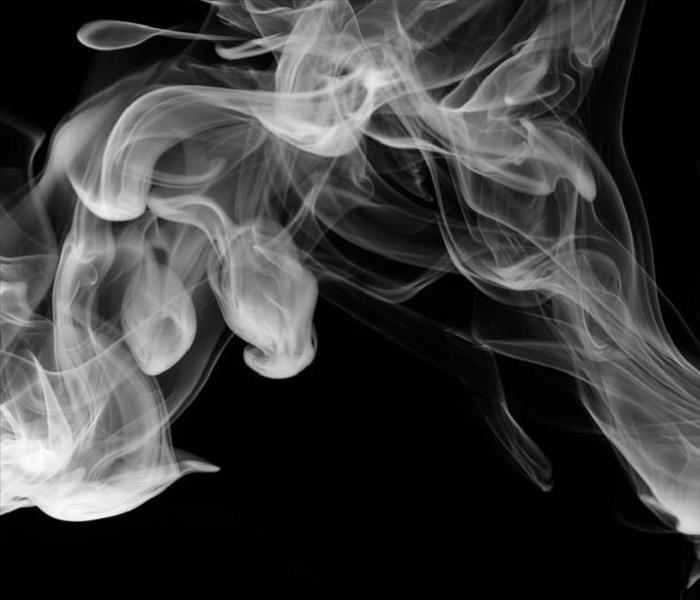Understanding the Impact of Smoke
6/10/2022 (Permalink)
Fire is dangerous. We all know that. But, did you know that the flames themselves might not be the greatest risk as far as property damage? Fire smoke is the leading cause of fire deaths, exceeding burns by a three-to-one ratio. And while direct exposure to smoke is said to be harmful to your respiratory system, it can also negatively affect your property’s structure, sometimes in unexpected ways.
Smoke from any type of fire is comprised of carbon monoxide, carbon dioxide and soot. Depending on what’s burning, many other harmful chemicals also enter the air and latch onto walls, furniture, clothing, ductwork and other areas.
When it comes to your property, knowing how temperature, the surrounding environment, particle ionization and airflow patterns affect smoke distribution can help you better restore your property to normal. To better understand how smoke behaves during a fire, review this information from the experts at SERVPRO.
Temperature
Because hot air rises, smoke damage is most commonly found in the following places:
- Directly above where the fire blazed: Assuming no strong air currents are flowing through the building, the highest concentration of smoke residue is usually found on the ceiling above the fire.
- Outside walls and windows: Cold air sinks below warmer air, opening up a path for the smoke to travel to exterior windows and walls. Even if the fire is concentrated in the center of the room, it’s common to find lots of smoke residue on outside walls.
Surrounding Environment
Homes have furniture, decorations, enclosed spaces and other features that interact with smoke. Sometimes smoke damage is found in seemingly bizarre places, but once you break down what causes it to interact with the surrounding environment, it begins to make sense. For example, smoke damage is often found:
- In seemingly enclosed spaces: Dresser drawers, closed closets and wall cavities that seem closed off often have more smoke damage than the area where the fire blazed. The reason is because molecules are more excited in warmer air. The rapid movement creates higher energy sufficient enough to carry smoke particles in the air. In cooler air where molecules move more slowly, there’s not enough energy to keep particles aloft, so they fall out of the airstream and onto surfaces in these cooler, relatively enclosed areas.
- Behind drapes and on blinds: There’s often a big temperature difference between the room and the space behind the drapes. Because smoke naturally moves to cooler areas, it’s common to find much more smoke residue behind the drapes than on the surface facing the room. Likewise, venetian blinds and pull shades often attract smoke residue more than surrounding surfaces, making the smoke damage here a good indicator of the true overall damage.
Particle Ionization
Smoke particles are often ionized, meaning they possess an electrical charge that attracts them to certain surfaces. That’s why you often find smoke damage:
- Surrounding nail heads in the ceiling: While hidden by drywall, metal nail heads still create a magnetic attraction, causing ionized smoke particles to land in a ring around them. The outline disappears after the smoke damage has been cleared away.
- Clustered in cobweb-like shapes in corners of the room: When plastics burn, the smoke carries a stronger charge than when wood, cotton or paper burns. Sometimes, this causes smoke residue to form “smoke webs” where the walls and ceiling come together.
- On synthetic materials: Manmade furnishings tend to end up with more residue on them after a fire than natural materials because they have greater ionization characteristics that attract smoke particles. Vinyl in particular can attract such high concentrations of smoke that it becomes permanently stained.
Airflow Pattern
Air currents carry smoke and soot away from the fire and deposit residue in interesting ways. For example, smoke damage is often seen:
- In ductwork: Even when the forced-air system isn’t running, smoke still finds its way into the cooler ductwork. The passageway leads the smoke to rooms far away from the fire, resulting in damage to areas that would otherwise have seen little or no impact from the blaze.
- On the far side of door openings: Smoke flows around things in its way like water passing around stones in a stream. These obstructions act like filters, causing more smoke residue to be deposited on the far side of door openings and the ceilings right above. This pattern diminishes the further away the smoke travels from the fire.
In the end, while smoke damage may seem erratic and random, it’s all in the physics. Understanding this may help take the mystery out of an already stressful situation. If you experience smoke damage, call SERVPRO of Columbia & Suwannee Counties located in North Central Florida and restore your property.




 24/7 Emergency Service
24/7 Emergency Service
